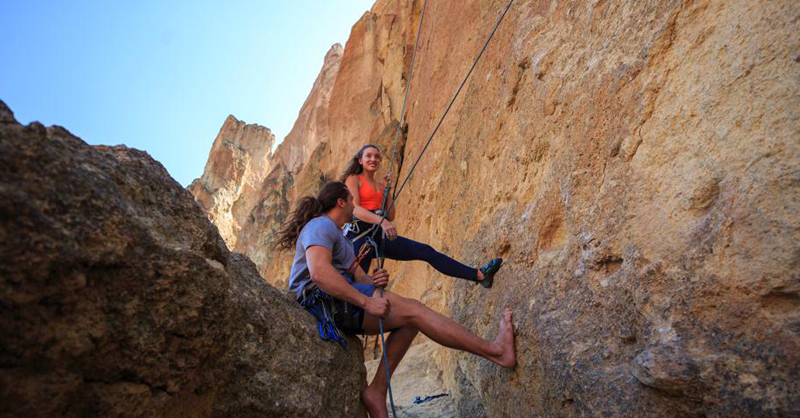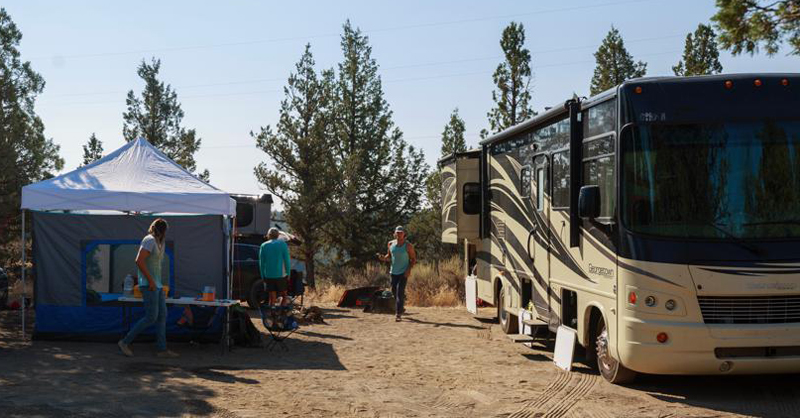Adapting Adventure Travel In A Changing World
Tristan Hamm sat on the coast of Oregon around a pulsing, orange campfire. The rhythmic sounds of DJ Samuel Lawrence danced through the background as a haze from West Coast wildfires enveloped Hamm’s small crew of adventurers and Lawrence’s makeshift DJ booth. Together, Hamm’s group had trekked from Los Angeles to Oregon just as the summer’s fire season descended in earnest. With no way out but to skirt around the blaze, the team was making the best of things.
Lawrence, a local artist and Oregon sensation, was happy to oblige.
A rock climber and former foreman for Canadian oil pipelines, Hamm has spent the last half of the decade manning the helm of an ever-expanding adventure company, Revived Outdoors. When COVID-19 hit, Hamm’s living pipe dream was placed in jeopardy. But like guide companies and outfitters around the United States, Revived Outdoors is finding new ways to thrive in a climate where almost everything that can go wrong seems to be doing so all at once. And their story paints a portrait of what domestic travel could look like for the foreseeable future.

According to the Outdoor Recreation Roundtable, a coalition of outdoor recreation member associations comprising about 110,000 outdoor-based businesses, about 88% of outdoor-related businesses laid off or furloughed employees at the onset of COVID-19. But by September, industry trends saw around 80% of guides and outfitters operating on some level, many scrambling to recoup losses during a shortened operating season.
For Hamm, the pandemic meant a screeching halt to a three-million dollar enterprise that caters to everyone from hardcore mountain climbers to soul searching C-level executives. It meant free diving excursions in Hawaii, heli-skiing expeditions in Canada and mountain climbing treks through California were halted. It meant adapting payroll employees from field guides to marketing gurus, a handful of layoffs and a halt on contract workers. And it meant time for reflection amidst a wild ride that has seen Hamm—a glamrock-styled adventurer— rise from pipeline worker to Instagram influencer to mental health advocate and successful CEO.
“We put everything on pause,” he says. “Absolutely everything got put on hold. But for me personally, it was a nice thing, because we were growing so fast that we needed time to focus on things that get neglected when you’re growing quickly. In the long run, it may also help us because the pandemic is putting a focus on the importance of domestic travel, which is what we are. That’s what we do.”
Pandemic pivot
Faced with stringent COVID-19 regulations and a full calendar of trips ranging from $3,000 to upwards of $30,000 on hold, Revived Outdoors decided to put their intimate knowledge of North America’s natural lands to work in another capacity. Rather than a slate of guided adventures, they’d leverage their collective experience in video production to bring brands into outdoor spaces they might otherwise overlook.
“Our pivot was to focus in on the marketing and production side of our company,” adds Hamm. “We have an ambitious team of qualified people in marketing, video production and sales. We package those skills up and offer them to companies that are hurting right now...we are building video campaigns and marketing campaigns. Many people are still able to buy products as long as they have a reason to buy products right now.”

The group’s Oregon venture was part of Revived’s first production trip since COVID-19 and the first to integrate giveaway winners from their online community. Using a 30-foot RV and two off-road vehicles, Hamm’s team ferried eight people from 725 miles from Los Angeles up to Crater Lake National Park and over towards the city of Eugene before wildfires forced an emergency evacuation and an audible back down the coast to California. Along the way, they’d collect footage for two private companies, and they’d bring along two giveaway winners who’d tag-along as part of the crew free of charge. “We had an entire week planned out there, but we had to get out. We decided as a team to bee line it back down south as fast as we could, get through the smoke and continue on.”
That’s how the team wound up on an obscure the beach with a DJ and a small bonfire, a humble scene compared to the splendor of Crater Lake. But as national parks become increasingly crowded due to an influx of people seeking accessible recreation outdoors, the secluded scene may become a more frequent sight for domestic adventurer travelers.
“I think the future of the travel industry is domestic travel in more remote, beautiful places,” adds Hamm. “People are going to realize there’s a lot to do in the United States that will open up opportunities for places like smaller towns that aren’t doing so well, but may have some cool little secret spots.”
Check out the full article from Forbes here.
Please Sign in to View
Log in to view member-only content.
If you believe you are receiving this message in error contact us at memberservices@rvia.org.
